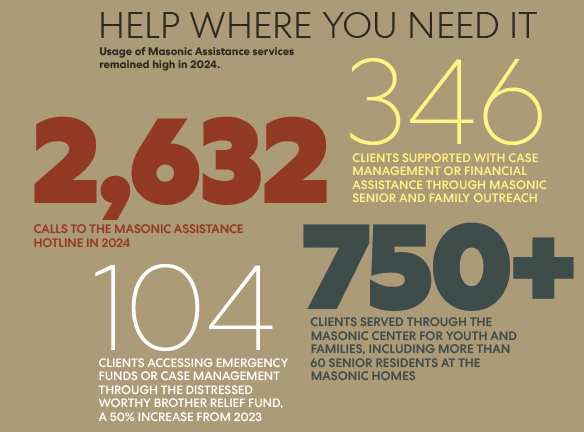
2024 FRATERNITY REPORT
Masonic Assistance Report: Better for All
Thanks to an expansion in eligbility, Masonic Assistance is serving more people than ever.
Download the Masons of California 2024 Fraternity Report here, or view individual stories through the links below.
For centuries, Masons have taken an obligation to care for their fellow members and their families. But who exactly is counted among that family?
Over the past year, the concept of Masonic family grew more inclusive in California—and allowed more people than ever access to the supports and services offered through Masonic Assistance. “This is a huge change,” says Sabrina Montes, vice president of community-based services for the Masonic Homes of California. “It’s about being able to serve Masons and meet them wherever they are and whatever their needs are.”
The expansion, announced in late 2023, extends admission to the Masonic Homes’ senior residences to not just California Masons and their partners, but for the first time, also to their parents and parents-in-law, and their surviving spouses, who in turn have two options for payment: First, a simple fee-for-service arrangement, or, for those related to a California Mason who has been in good standing for five years, an assignment-of-assets model that’s partially underwritten by charitable dollars. The latter offer also extends to Entered Apprentice and Fellow Craft Masons, as well as members of the Prince Hall Grand Lodge of California and the Grand Lodge of Iran in Exile. Other Masonic Assistance programs also saw an expansion of eligibility: Prince Hall and Iran in Exile Masons are now able to receive support through Masonic Outreach Services, including case management and prescription-drug discounts, while groups including the Order of the Eastern Star are now eligible for the Shared Housing program in Covina.
Says Montes, “Historically, admission was only open to Masons or their widows, so the fact that we can now serve more of that Mason’s family is really important. In the past, we could never help a Mason’s father, for instance. To be able to assist a Mason by helping their parents or parents-in-law, it’s wonderful to be able to open that door.”
The new model is still in its infancy; from December 2023 through November 2024, a total of 52 newly eligible people (parents, parents-in-law, Prince Hall members, etc.) applied for residency. More than 100 have already called Masonic Assistance to get more information or begin the process of applying. Says Sol Silverman, director of Masonic Assistance, “We knew it would take a little bit to get the word out there, but that it would just be a matter of time before they start blowing up our phone.”
Above:
Representatives from the Masonic Homes and the Prince Hall Grand Lodge of California tour the Union City Campus in early 2024, part of an expansion of eligibility to the Homes announced in 2024.
Coming Back Strong
Five years since the outbreak of COVID-19, occupancy has finally rebounded at the Masonic Homes and Acacia Creek, with 88 percent of apartments at the Masonic Homes’ campus in Union City and 98 percent at Covina now occupied, along with nearly 90 percent of those at Acacia Creek—up from 69 percent in the depths of the pandemic.
Usage of other Masonic Assistance services remains high: Calls to the central hotline reached 2,632 in 2024, while the Masonic Senior Outreach Services program retained its record-high client list at more than 300, about half of whom received financial assistance totaling some $2.5 million. The Masonic Family Outreach Services program also provided case management and other resources for couples and children of Masons. The Masonic Center for Youth and Families served 750 clients around the state, including 60 senior residents of the Masonic Homes.
The largest spike came from calls to the Distressed Worthy Brother Relief Fund, developed in 2020 to provide one-time financial support to Masons and their families in times of crisis. In fiscal year 2024, that program supported 104 Masons (up 50 percent over 2023), 67 of whom accessed emergency funds. The rest were connected to care managers and other resources.
“Credit for that goes to our lodges, who did a lot more outreach to members in distress,” says Amy Averweg, director of Masonic Senior and Family Outreach Services. “They were getting that word of mouth out, so folks were reaching out a lot more.”
To that end, staff from the Masonic Outreach team held numerous training sessions around the state in 2024, arming hundreds of Masons with information and advice on making contact with members in need. Staff from MOS also presented up and down the state at lodge meetings.

Aligning Services
Less visible, but perhaps just as important, was a change to Masonic Assistance through a behind-the-scenes rearranging of the organization. In 2024, the Masonic Center for Youth and Families moved its Northern California headquarters from the Presidio in San Francisco, where it had been located since launching in 2010, to the former administrator’s home at the Masonic Homes campus in Union City.
In addition to the efficiency of operating just steps from the Masonic Homes’ central administration building, the move better allows MCYAF to serve the senior residents there—a growing part of its clientele. Similar to the on-campus model MCYAF uses at the Masonic Homes in Covina, this change also opens up opportunities for that organization to partner with community and educational groups in the Tri-City area, many of which are already closely connected to the Masonic Homes and Acacia Creek.
Even more consequential was the unanimous decision of the board this summer to appoint Terry Quigley as chief executive of Acacia Creek Retirement Community. Quigley, who was hired as CEO of the Masonic Homes in July 2023, will now assume executive responsibility for both organizations, allowing services to be better aligned. That can already be seen in the shared sales and marketing team, which is able to route and refer calls for assistance from Masons and non-Masons to where they’re needed.
The result, leaders envision, is a single shared campus offering a range of services, from independent living to assisted living to skilled nursing and memory care. Masons and others can choose the environment and payment plan that best suits them.
Now, 125 years from the date that the first cohort of Masons, widows, and orphans set foot in the regal brick building atop the hill, the Masonic Homes have swung the doors open even more widely, to more people than ever, and with even more services and facilities available. But the commitment to care and the obligation underlying it have not changed. “It’s about caring for Masons,” Montes says. “That will always be there.”

